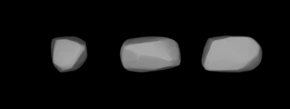531 Zerlina , provisional designation 1904 NW, carbonaceous Palladian asteroid from the central region of the asteroid belt , approximately 18 kilometers in diameter. It was discovered by German astronomer Max Wolf at the Heidelberg-Königstuhl State Observatory on 12 April 1904.[ 16]
Orbit and characteristics
Observations using the IRAS satellite have shown it to have an absolute magnitude of 11.8, a diameter of 15.19 kilometers, a rotational period of 16.706 hours, and an albedo of 0.1460.[ 1]
Naming
It is named for a character in Mozart's opera, Don Giovanni H 57 [ 3]
References
^ a b c d e "JPL Small-Body Database Browser: 531 Zerlina (1904 NW)" (2016-11-04 last obs.). Jet Propulsion Laboratory . Retrieved 4 September 2017 .^ John Mario, Batti batti – Italian Pronunciation Guide #14 for Singers , YouTube
^ a b Schmadel, Lutz D. (2007). "(531) Zerlina". Dictionary of Minor Planet Names – (531) Zerlina . Springer Berlin Heidelberg . p. 56. doi :10.1007/978-3-540-29925-7_532 . ISBN 978-3-540-00238-3 ^ "Asteroid 531 Zerlina – Nesvorny HCM Asteroid Families V3.0" . Small Bodies Data Ferret . Retrieved 24 October 2019 .^ a b c Masiero, Joseph R.; Mainzer, A. K.; Grav, T.; Bauer, J. M.; Cutri, R. M.; Nugent, C.; et al. (November 2012). "Preliminary Analysis of WISE/NEOWISE 3-Band Cryogenic and Post-cryogenic Observations of Main Belt Asteroids" . The Astrophysical Journal Letters . 759 (1): 5. arXiv :1209.5794 Bibcode :2012ApJ...759L...8M . doi :10.1088/2041-8205/759/1/L8 . S2CID 46350317 . Retrieved 4 September 2017 . ^ a b c Nugent, C. R.; Mainzer, A.; Bauer, J.; Cutri, R. M.; Kramer, E. A.; Grav, T.; et al. (September 2016). "NEOWISE Reactivation Mission Year Two: Asteroid Diameters and Albedos" . The Astronomical Journal . 152 (3): 12. arXiv :1606.08923 Bibcode :2016AJ....152...63N . doi :10.3847/0004-6256/152/3/63 S2CID 119289027 . ^ a b c Usui, Fumihiko; Kuroda, Daisuke; Müller, Thomas G.; Hasegawa, Sunao; Ishiguro, Masateru; Ootsubo, Takafumi; et al. (October 2011). "Asteroid Catalog Using Akari: AKARI/IRC Mid-Infrared Asteroid Survey". Publications of the Astronomical Society of Japan . 63 (5): 1117– 1138. Bibcode :2011PASJ...63.1117U . doi :10.1093/pasj/63.5.1117 . online , AcuA catalog p. 153 )^ a b c d e "LCDB Data for (531) Zerlina" . Asteroid Lightcurve Database (LCDB). Retrieved 4 September 2017 .^ a b c Tedesco, E. F.; Noah, P. V.; Noah, M.; Price, S. D. (October 2004). "IRAS Minor Planet Survey V6.0" . NASA Planetary Data System . 12 : IRAS-A-FPA-3-RDR-IMPS-V6.0. Bibcode :2004PDSS...12.....T . Retrieved 22 October 2019 . ^ a b c Alí-Lagoa, V.; Licandro, J.; Gil-Hutton, R.; Cañ; ada-Assandri, M.; Delbo', M.; et al. (June 2016). "Differences between the Pallas collisional family and similarly sized B-type asteroids" . Astronomy and Astrophysics . 591 : 11. Bibcode :2016A&A...591A..14A . doi :10.1051/0004-6361/201527660 hdl :11336/63614 ^ a b c Alí-Lagoa, V.; de León, J.; Licandro, J.; Delbó, M.; Campins, H.; Pinilla-Alonso, N.; et al. (June 2013). "Physical properties of B-type asteroids from WISE data" . Astronomy and Astrophysics . 554 : 16. arXiv :1303.5487 Bibcode :2013A&A...554A..71A . doi :10.1051/0004-6361/201220680 . S2CID 119214002 . Retrieved 4 September 2017 . ^ a b c Mainzer, A.; Grav, T.; Masiero, J.; Hand, E.; Bauer, J.; Tholen, D.; et al. (November 2011). "NEOWISE Studies of Spectrophotometrically Classified Asteroids: Preliminary Results". The Astrophysical Journal . 741 (2): 25. arXiv :1109.6407 Bibcode :2011ApJ...741...90M . doi :10.1088/0004-637X/741/2/90 . S2CID 118700974 . ^ Székely, P.; Kiss, L. L.; Szabó, Gy. M.; Sárneczky, K.; Csák, B.; Váradi, M.; et al. (August 2005). "CCD photometry of 23 minor planets" . Planetary and Space Science . 53 (9): 925– 936. arXiv :astro-ph/0504462 Bibcode :2005P&SS...53..925S . doi :10.1016/j.pss.2005.04.006 . S2CID 119361591 . Retrieved 4 September 2017 . ^ Brinsfield, James W. (June 2008). "The Rotation Periods of 531 Zerlina, 1194 Aleta 1352 Wawel, 2005 Hencke, 2648 Owa, and 3509 Sanshui" . The Minor Planet Bulletin . 35 (2): 86– 87. Bibcode :2008MPBu...35...86B . ISSN 1052-8091 . Retrieved 4 September 2017 . ^ Pilcher, Frederick; Brinsfield, James W. (October 2011). "Rotation Period Determination for 531 Zerlina" . The Minor Planet Bulletin . 38 (4): 206. Bibcode :2011MPBu...38Q.206P . ISSN 1052-8091 . Retrieved 4 September 2017 . ^ "531 Zerlina (1904 NW)" . Minor Planet Center . Retrieved 4 September 2017 .
External links
